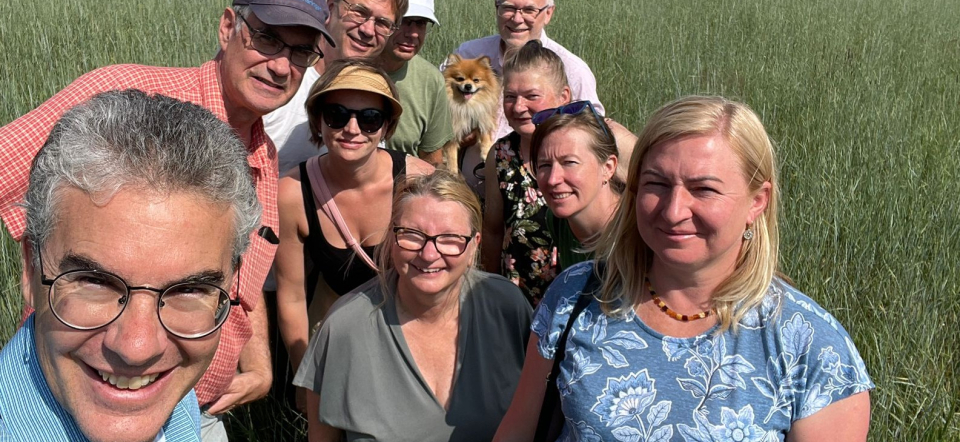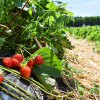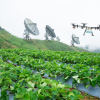The next agricultural revolution could be due to perennial grain crops and one of them is leading the way; the intermediate wheatgrass Kernza. Kernza is a perennial grass which has been bred to increase its seed size. It is now the first commercially available perennial grain crop. But what does that mean?
“All our other grains, like wheat, barley, rye, oats, maize, and rice are annual and so you need to replant them annually. Being perennial it means once you plant it, Kernza grows back and can be harvested year after year. The other important thing about Kernza is it's a dual use crop. It can be used for both grain and forage, and the farmers can harvest both things in the same year. It’s two products and two sources of income in the same year from one crop”, explains Valentin Picasso, Professor of cropping systems at the Swedish University of Agricultural Sciences SLU.
He is the leader of the project Validating the Introduction of Kernza in the Nordic-Baltic region (Viking) which explores the potential of Kernza in Sweden, Norway, Finland, Estonia, and Lithuania. In Sweden there has been long-term trials on Kernza for about ten years, but in all the other countries this is the first time Kernza is being tested.
The project includes two experiments. The first one with different levels of nitrogen fertilizer and intercropping with red clover to optimise grain production. Red clover is a legume which can fix nitrogen, so intercropping with red clover brings diversity to the field and reduces the need for fertilizers. The second experiment is testing different harvesting timing of the forage and intercropping with lucerne, another forage legume. The project is also testing the winter hardiness of Kernza.
Intermediate wheatgrass Kernza
- Perennial, regrows yearly
- Dual-use crop: forage and grain.
- Originally from Europe, used as forage crop.
- Selected for seed production and bred since the 1990s to increase the seed size.
- The first commercially available perennial grain crop.
- Grain can be used for baking, pasta, pancakes, beer and spirits.
- Low in gluten, but not gluten free.
- A very tall crop that can reach 1,5 meters.
- Has very deep and dense root system, can therefore fix much carbon in the soil.
Climate friendly crop
The Viking team wants to introduce Kernza to the Nordics and Baltics because of its ability to mitigate climate change. Kernza has a deep and dense root systems making it able to fix a lot of carbon in the soil. The crop also provides habitat for biodiversity because it continuously covers the soil. This prevents soil erosion and therefore better water quality because there is less runoff and leaching of nutrients to the water.
“The main reason we are interested in this crop is because of its many environmental benefits. The cultivation process emits less greenhouse gases because the soil doesn’t need to be tilled annually, and less herbicides and pesticides are needed because Kernza covers the ground year-round”, says Valentin Picasso.
Promising results for Kernza in the region
The project has completed two full years of data collection on both grain and forage and still has another year left. The preliminary findings show encouraging results, according to Picasso, although the yield of Kernza is generally much lower than for annual grains.
“One thing we discovered is that Kernza seems to grow well in the Baltics. In Lithuania they harvested up to two tons per hectare, which is a very high yield for what we have seen elsewhere with this crop. The forage production of Kernza has been good, we can have anywhere between five to ten tons of forage per hectare every year. So, when you add up both the forage and the grain, it's financially viable, he says.
The early findings also indicate that Kernza can resist the Nordic winter well as the crop has recovered from the winter in all sites.
“The results from forage quality analysis are encouraging as well. They show that Kernza forage contains high protein levels and much energy, so we think that it can be integrated well in feed for beef cattle, but also in dairy systems. Based on these preliminary findings, we think there is a lot of potential for this crop in northern Europe”, says Picasso.
Newcomer in the Nordic-Baltic region
Kernza is a new crop for the region, but according to Picasso, it has been well received by the industry and big companies are following the project closely. Like other grains, Kernza can be used for making flour and baking but also fermenting and beer brewing.
“In the Nordics and Baltics, there are small bakeries and companies that have discussed with our researchers and developed their own little side projects testing Kernza. The grain is still small compared to wheat or barley as it contains less starch and more proteins and other nutrients. Bakers have tried mixing different proportions of Kernza with wheat or ancient grains such as spelt, and have baked cookies, sourdough bread, dark bread and so on. Kernza brings a special, nutty or earthy flavour, according to them”, he says.

The projects main stakeholders are the farmers and in each country the project has demonstration sites with farmers.
“Interacting with the farmers has been one of the most interesting things with the project. The production of grain and forage at the same time is a completely new. The farmers bring practical knowledge, creativity and experience and their management ideas are often much more interesting than what we researchers can think of. We've learned all about the post-harvest processing, storage, preservation and industrialization from them.”
The next agricultural revolution
The long-term aim of the project is to consolidate and expand Kernza with the value chains, and for Kernza to become an important crop that is part of the statistics alongside main grains such as wheat.
“So that means that we are really going for large areas. We are not working with a niche crop that will grow in small areas, is of high value and available only for a few people”, says Valentin Picasso.
It is also important to continue diversifying the options for perennial grain crops and start testing perennial cereal rye, perennial wheat and other perennial crops, like sainfoin or sunflower, according to him.
“The first agricultural revolution really changed societies to established civilizations. The second was the Green Revolution that dramatically changed the yields by plant breeding and use of nitrogen fertilizers and pesticides that have had negative impact on the environment. So far, all the innovations have just mitigated the problem, but not solved it. Developing perennial grain crops is, I think, the third major agricultural revolution. That’s the level of impact we are hoping for. We want to transform the landscape of agriculture in Europe with more perennials and more diversity, he says.






